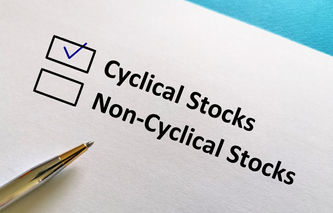With stock ownership, it's certainly possible to have too much of a good thing. Diversity of stock holdings is important, just ask any former employee of Enron. When that company filed for bankruptcy, thousands of employees lost nearly all their savings. In this article, we're going to explain why experts feel investors should avoid putting more than 10% of their portfolio's assets into one company's stock. We'll also explain how to go about diversifying a portfolio, as well as providing an example to demonstrate the positive impact holding an assortment of stocks can have on your return on investment.
Diversification
When spreading money across a variety of investments to reduce risk, you're practicing diversification. If the right groups of investments are chosen, then it's even possible to limit a potential loss without compromising the potential for a gain.
Owning too Much of One Stock
A much-cited example of the pitfalls of owning too much of one stock is what happened at Enron in late 2001. Studies conducted after Enron filed for bankruptcy showed that 57.7% of the 401(k) plan funds at Enron were invested in company stock. When the price of Enron's stock fell by nearly 99% in 2001, employees were financially devastated. The publicity around the Enron debacle highlighted the risks that some companies allowed, and even encouraged. This misfortune subsequently prompted several studies aimed at quantifying the extent to which employees hold stock in the companies for which they work. A study conducted by the Investment Company Institute (ICI) and the Employee Benefits Research Institute (EBRI) conducted in 2001 found the following:
Nearly 25% of employees over the age of 60 held 50% or more of their 401(k) funds in company stock.
Sixteen percent of employees over the age of 60 held 80% or more of their 401(k) funds in company stock.
More recently, a study conducted by Financial Week and Pensions & Investments evaluated the 401(k) asset allocation strategy for 65 of the largest corporate defined-contribution plans. That study found:
Over 81% of these companies had 10% or more of their 401(k) assets invested in company stock.
Forty-two percent of these companies had 25% or more of their 401(k) assets invested in company stock.
Several companies included in the study, such as General Electric, Duke Energy and Chevron, had more than half of their plan's assets in company stock.
Because of the difficulty and cost associated with creating a portfolio of stocks, many investors turn to mutual funds.Moneyzine Editor
To put these percentages in perspective, financial planners typically recommend that not more than 10 to 20% of an individual's assets be placed in one company's stock. This recommendation stems from the fact that owning too much of one stock increases the risk of that individual's portfolio.
Individual Stock Risk and Diversification
Employees typically invest in their companies because of a natural tendency to invest in something that is familiar. Adding to that tendency is a natural fear of the unknown. These two human factors result in the unusually large holdings of single stocks by individuals. Financial planners understand that diversification can reduce the risk associated with investing in stocks. It's possible to demonstrate the benefits of holding a diverse portfolio of securities with a simple example.
Reducing Risk: Example
In this example, the universe of stocks is limited to ten companies, and there are eleven investors. Ten of these investors have 100% of their assets placed in a single stock, while one investor spreads 10% of their assets throughout a portfolio consisting of the ten companies. In this example, one of the companies files for protection under Chapter 11 bankruptcy and the shares of that stock have no value. The remaining nine companies all provide a 10% return on investment. The results of this example include:
Nine investors received a 10% return on their investment.
One investor lost all their money.
One investor received a 9% return on their investment.
By holding a diverse set of stocks, the investor realized a slightly lower return on investment, but they also eliminated individual stock risk. This example demonstrates the first layer of protection that holding a variety of stocks offers investors.
Stock Portfolios
Generally, an investor acquires two risks when they own stocks. The first risk is individual stock risk, and that risk can be reduced through diversification as shown in the above example. The second risk is market risk. This second risk is influenced by macroeconomic conditions, such as a recession or depression, and / or investor faith in the stock market itself. While it's relatively easy to reduce the risk associated with the performance of one company's stock, it's much more difficult to reduce market risk. In fact, there is even a measure that tells us how strong the relationship is between the market's overall movement and that of an individual stock; that measure is called the stock's beta.
Stock Beta Values
The beta value of a stock quantifies the likelihood that a stock's price will increase or decrease at the same rate as the overall market:
A stock with a beta > 1.0 can be expected to experience price swings that are greater than the market's movements.
A stock with a beta = 1.0 can be expected to experience price swings similar to the market's movements.
A stock with a beta between 1 and 0 can be expected to experience price swings that are less volatile than the market's movements.
A stock with a beta < 0 (a negative beta) can be expected to experience price swings that run counter to the market's movements.
Please note that while it is mathematically possible for a stock to have a negative beta, the actual occurrence of this condition is extremely rare.
Investment Sectors
One strategy that investors adopt to help reduce the risk of their stock holdings is to diversify not only by holding shares of stock in a variety of companies, but also to diversify across industries or sectors. The most widely recognized market sectors include:
Information: hardware, media software, telecommunications
Service: business services, consumer services, financial services, healthcare
Manufacturing: consumer goods, energy, industrial materials, utilities
What the investor is trying to achieve by spreading their dollars across a variety of sectors is a variety in performance. That is, each sector can be expected to perform differently under a variety of market conditions, thereby offering the investor the possibility of extraordinary gains in one sector even if another sector underperforms relative to the overall market. Just how many different stocks does it take to have a diversified portfolio? Nearly all financial planners agree that an investor needs to own 10 to 30 different stocks before claiming to hold a truly diversified portfolio.
Assembling a Portfolio of Stocks
To achieve relatively low fixed costs (transaction fees), it's often necessary to purchase at least 100 shares of a company's stock. If the average price per share of stock is $40, then the investment necessary to assemble a diversified portfolio of stocks can be calculated as: = Price per Share x 100 Shares x 10 Companies = $40 x 100 Shares x 10 Companies, or $40,000 In this example, the investor not only needs $40,000 to create their portfolio, but also needs to conduct extensive research when selecting stocks. Because of the difficulty and cost associated with creating a portfolio of stocks, many investors turn to mutual funds. Even with mutual funds, the investor still needs to conduct research since it's possible to find narrowly-focused mutual funds specializing in a specific sector of stocks. But the level of effort and lower cost of entry make mutual funds a very attractive option.






